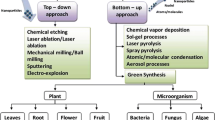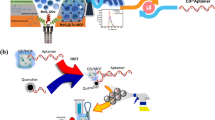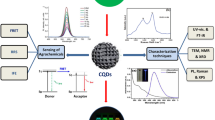Abstract
The exceptional ascending heights of graphene (carbon) and boron nitride nanostructures have invited scientists to explore metal nitride nanomaterials. Herein, Zn3N2 quantum dots (QDs) were prepared via a simple hydrothermal route from the reaction between zinc nitrate hexahydrate and ammonia solution that possess efficient strength towards sensing applications of metal ions (Cu2+ and Mn2+). The as-prepared Zn3N2 QDs show bright fluorescence, displaying an emission peak at 408 nm upon excitation at 320 nm, with a quantum yield (QY) of 29.56%. It was noticed that the fluorescence intensity of Zn3N2 QDs linearly decreases with the independent addition of Cu2+ and Mn2+ ions, displaying good linearity in the ranges 2.5–50 µM and 0.05–5 µM with detection limits of 21.77 nM and of 63.82 nM for Cu2+ and Mn2+ ions, respectively. The probe was successfully tested for quantifying Cu2+ and Mn2+ in real samples including river, canal, and tap water, providing good recoveries with a relative standard deviation < 2%. Furthermore, the masking proposition can successfully eliminate the interference if the two metal ions exist together. It was found that thiourea is efficiently able to mask Cu2+ and selectively quenches Mn2+, and l-cysteine is able to halt the quenching potential of Mn2+ and is selectively able to sense Cu2+. The Zn3N2 QDs provide a simple way for the simultaneous detection of both Cu2+ and Mn2+ ions in environmental samples at low sample preparations requirements.
Graphical Abstract










Similar content being viewed by others
Data availability
Data will be available from the corresponding author on demand.
References
Deepalakshmi T, Tran DT, Kim NH, Chong KT, Lee JH (2018) Nitrogen-doped graphene-encapsulated nickel cobalt nitride as a highly sensitive and selective electrode for glucose and hydrogen peroxide sensing applications. ACS Appl Mater Interfaces 10:35847–35858. https://doi.org/10.1021/acsami.8b15069
Yu X, Zhou T, Ge J, Wu C (2020) Recent advances on the modulation of electrocatalysts based on transition metal nitrides for the rechargeable Zn-air battery. ACS Mater Lett 2:1423–1434. https://doi.org/10.1021/acsmaterialslett.0c00339
Naldoni A, Guler U, Wang Z, Marelli M, Malara F, Meng X, Besteiro LV, Govorov AO, Kildishev AV, Boltasseva A, Shalaev VM (2017) Broadband hot-electron collection for solar water splitting with plasmonic titanium nitride. Adv Opt Mater 5:1601031. https://doi.org/10.1002/adom.201601031
Lalisse A, Tessier G, Plain J, Baffou G (2016) Plasmonic efficiencies of nanoparticles made of metal nitrides (TiN, ZrN) compared with gold. Nat Publ Gr 6:38647. https://doi.org/10.1038/srep38647
Singh PDD, Murthy ZVP, Kailasa SK (2023) Metal nitrides nanostructures: properties, synthesis and conceptualization in analytical methods developments for chemical analysis and separation, and in energy storage applications. Coord Chem Rev 481:215046
Balamurugan J, Duy T, Hoon N, Hee J (2016) Facile fabrication of FeN nanoparticles/nitrogen-doped graphene core-shell hybrid and its use as a platform for NADH detection in human blood serum. Biosens Bioelectron 83:68–76. https://doi.org/10.1016/j.bios.2016.04.040
Li Y, Du R, Li W, Li J, Yang H, Bai H, Zou M, Xi G (2021) δ - MoN yolk microspheres with ultrathin nanosheets for a wide-spectrum, sensitive, and durable surface-enhanced raman scattering substrate. Anal Chem 93:12360–12366. https://doi.org/10.1021/acs.analchem.1c02181
Prabha S, Durgalakshmi D, Subramani K, Aruna P, Ganesan S (2020) Enhanced emission of zinc nitride colloidal nanoparticles with organic dyes for optical sensors and imaging application. ACS Appl Mater Interfaces 12:19245–19257. https://doi.org/10.1021/acsami.9b21585
Ning G, Li B, Liu J, Xiao Q, Huang S (2022) Red-emission carbon dots as fluorescent “on–off–on” probe for highly sensitive and selective detection of Cu2+ and glutathione. Anal Bioanal Chem 414:2219–2233. https://doi.org/10.1007/s00216-021-03859-7
Feng Y, Zhou F, Deng Q, Peng C (2020) Solvothermal synthesis of in situ nitrogen-doped Ti3C2 MXene fluorescent quantum dots for selective Cu2+ detection. Ceram Int 46:8320–8327. https://doi.org/10.1016/j.ceramint.2019.12.063
Alam MZ, Alimuddin SA, Khan A (2023) Review on Schiff base as a versatile fluorescent chemo-sensors tool for detection of Cu2+ and Fe3+ Metal Ion. J Fluoresc. 33(2023):1241–1272. https://doi.org/10.1007/s10895-022-03102-1
Khan MMR, Mitra T, Sahoo D (2020) Metal oxide QD based ultrasensitive microsphere fluorescent sensor for copper, chromium and iron ions in water. RSC Adv 10:9512–9524. https://doi.org/10.1039/c9ra09985a
Grim JQ, Manna L, Moreels I (2015) A sustainable future for photonic colloidal nanocrystals. Chem Soc Rev 44:5897–5914. https://doi.org/10.1039/c5cs00285k
Ding N, Zhou D, Pan G, Xu W, Chen X, Li D, Zhang X, Zhu J, Ji Y, Song H (2019) Europium-doped lead-free Cs3Bi2Br9 perovskite quantum dots and ultrasensitive Cu2+ detection, ACS Sustain Chem Eng. 7 8397–8404. https://doi.org/10.1021/acssuschemeng.9b00038
Liu Y, Huang H, Cao W, Mao B, Liu Y, Kang Z (2020) Advances in carbon dots: from the perspective of traditional quantum dots. Mater Chem Front 4:1586–1613. https://doi.org/10.1039/d0qm00090f
Mishra V, Patil A, Thakur S, Kesharwani P (2018) Carbon dots: emerging theranostic nanoarchitectures. Drug Discov Today 23:1219–1232. https://doi.org/10.1016/j.drudis.2018.01.006
Ahumada-lazo R, Fairclough SM, Hardman SJO, Taylor PN, Green M, Haigh SJ, Saran R, Curry RJ, Binks DJ (2019) Confinement effects and charge dynamics in Zn3N2 colloidal quantum dots: implications for QD-LED Displays. ACS Appl Nano Mater 2:7214–7219. https://doi.org/10.1021/acsanm.9b01714
Taylor PN, Schreuder MA, Smeeton TM, Grundy AJD, Dimmock JAR, Hooper SE, Heffernan J, Kauer M (2014) Synthesis of widely tunable and highly luminescent zinc nitride nanocrystals. J Mater Chem C Mater 2:4379–4382. https://doi.org/10.1039/c4tc00403e
Fioretti AN, Pan J, Ortiz BR, Melamed CL, Dippo PC, Schelhas LT, Perkins JD, Kuciauskas D, Lany S, Zakutayev A, Toberer ES, Tamboli AC (2018) Exciton photoluminescence and benign defect complex formation in zinc tin nitride. Mater Horiz 5:823–830. https://doi.org/10.1039/c8mh00415c
Trapalis A, Farrer I, Kennedy K, Kean A, Sharman J, Heffernan J (2017) Temperature dependence of the band gap of zinc nitride observed in photoluminescence measurements. Appl Phys Lett 111:122105. https://doi.org/10.1063/1.4997153
Kuriyama K, Takahashi Y, Sunohara F (1993) Optical band gap of Zn3N2 films. Phys Rev B 48:2781–2782. https://doi.org/10.1103/PhysRevB.48.2781
Premkumar T, Vidya R (2019) Crystal and electronic structure studies on transparent conducting nitrides A3N2 (A = Mg, Zn and Sn) and Sn3N4 crystal and electronic structure studies on transparent conducting nitrides A3N2 (A = Mg, Zn and Sn) and Sn3N4. Mater Res Express 6:055912. https://doi.org/10.1088/2053-1591/ab0502
Ali HT, Jacob J, Zaman H, Mahmood K, Yusuf M, Mehboob K, Ikram S, Ali A, Amin N, Javaid K (2021) Successful growth of zinc nitride thin films by vacuum tube furnace using nitrogen as source gas. Ceram Int 47:18964–18968. https://doi.org/10.1016/j.ceramint.2021.03.239
Zaman H, Jacob J, Mehboob K, Mahmood K, Rehman U, Ikram S, Ali A, Ashfaq A, Amin N, Hussain S, Tanveer Z, Ul Ghani U (2020) Effect of annealing temperature on thermoelectric properties of zinc nitride thin films grown by thermal evaporation method. Ceram Int 46:25992–25995. https://doi.org/10.1016/j.ceramint.2020.07.089
Mandal P, Sahoo D, Sarkar P, Chakraborty K, Das S (2019) Fluorescence turn-on and turn-off sensing of pesticides by carbon dot-based sensor. New J Chem 43:12137–12151. https://doi.org/10.1039/c9nj03192h
Zhao X, Dai X, Zhao S, Cui X, Gong T, Song Z, Meng H, Zhang X, Yu B (2021) Aptamer-based fluorescent sensors for the detection of cancer biomarkers. Spectrochim Acta A Mol Biomol Spectrosc 247:119038. https://doi.org/10.1016/j.saa.2020.119038
Goshisht MK, Patra GK, Tripathi N (2022) Fluorescent Schiff base sensors as a versatile tool for metal ion detection: strategies, mechanistic insights, and applications. Mater Adv 3:2612–2669. https://doi.org/10.1039/d1ma01175h
Beatty MA, Selinger AJ, Li Y, Hof F (2019) Parallel synthesis and screening of supramolecular chemosensors that achieve fluorescent turn-on detection of drugs in saliva. J Am Chem Soc 141:16763–16771. https://doi.org/10.1021/jacs.9b07073
Li XS, Li YF, Wu JR, Lou XY, Han J, Qin J, Yang YW (2020) A color-tunable fluorescent pillararene coordination polymer for efficient pollutant detection. J Mater Chem A Mater 8:3651–3657. https://doi.org/10.1039/c9ta13776a
Wang J, Moore J, Laulhe S, Nantz M, Achilefu S, Kang KA (2012) Fluorophore gold nanoparticle complex for sensitive optical biosensing and imaging. Nanotechnology 23:095501. https://doi.org/10.1088/0957-4484/23/9/095501
Han S, Yang L, Wen Z, Chu S, Wang M, Wang Z, Jiang C (2020) A dual-response ratiometric fluorescent sensor by europium-doped CdTe quantum dots for visual and colorimetric detection of tetracycline. J Hazard Mater 398:122894. https://doi.org/10.1016/j.jhazmat.2020.122894
Yang F, Lin D, Pan L, Zhu J, Shen J, Yang L, Jiang C (2021) Portable smartphone platform based on a single dual-emissive ratiometric fluorescent probe for visual detection of isopropanol in exhaled breath. Anal Chem 93:14506–14513. https://doi.org/10.1021/acs.analchem.1c03280
Hu B, Kang X, Xu S, Zhu J, Yang L, Jiang C (2022) Multiplex chroma response wearable hydrogel patch: visual monitoring of urea in body fluids for health prognosis. Anal Chem 95:3587–3595. https://doi.org/10.1021/acs.analchem.2c03806
Hu B, Zhu J, Shen J, Yang L, Jiang C (2022) A portable sensing platform using an upconversion-based nanosensor for visual quantitative monitoring of mesna. Anal Chem 94:7559–7566. https://doi.org/10.1021/acs.analchem.2c00380
Wang H, Yang L, Chu S, Liu B, Zhang Q, Zou L, Yu S, Jiang C (2019) Semiquantitative visual detection of lead ions with a smartphone via a colorimetric paper-based analytical device. Anal Chem 91:9292–9299. https://doi.org/10.1021/acs.analchem.9b02297
Wang H, Da L, Yang L, Chu S, Yang F, Yu S, Jiang C (2020) Colorimetric fluorescent paper strip with smartphone platform for quantitative detection of cadmium ions in real samples. J Hazard Mater 392:122506. https://doi.org/10.1016/j.jhazmat.2020.122506
Chu S, Wang H, Ling X, Yu S, Yang L, Jiang C (2020) A portable smartphone platform using a ratiometric fluorescent paper strip for visual quantitative sensing. ACS Appl Mater Interfaces 12:12962–12971. https://doi.org/10.1021/acsami.9b20458
Xia Zhao L, Yu Chen K, Bo Xie K, Jun Hu J, Yu Deng M, Li Zou Y, Gao S, Fu Y (2023) Ye F (2023) A benzothiazole-based “on-off” fluorescence probe for the specific detection of Cu2+ and its application in solution and living cells. Dyes and Pigments. 210:110943. https://doi.org/10.1016/j.dyepig.2022.110943
Wang S, Guo L, Chen L, Wang L, Song Y (2022) Self-exfoliating double-emission n-doped carbon dots in covalent organic frameworks for ratiometric fluorescence “Off–On” Cu2+ detection. ACS Appl Nano Mater 5:1339–1347. https://doi.org/10.1021/acsanm.1c03889
Yu C, Zhang D, Zhu Q, Chao D, Liu H, Zhou L (2022) Preparation and characterisation of dual sensing carbon dots for water and Cu2+ detection. Dyes Pigm 198:110008. https://doi.org/10.1016/j.dyepig.2021.110008
Liang D, Liang X, Zhang Z, Wang H, Zhang N, Wang J, Qiu X (2020) A regenerative photoelectrochemical sensor based on functional porous carbon nitride for Cu2+ detection. Microchem J 156:104922. https://doi.org/10.1016/j.microc.2020.104922
Lee YJ, Lim C, Suh H, Song EJ, Kim C (2014) A multifunctional sensor: chromogenic sensing for Mn2+ and fluorescent sensing for Zn2+ and Al3+. Sens Actuators B Chem 201:535–544. https://doi.org/10.1016/j.snb.2014.05.035
Akhondi M, Jamalizadeh E (2020) Selective colorimetric detection of Mn2+ and Cr2+ ions using silver nanoparticles modified with sodium dodecyl sulfonate and β-Cyclodextrin. Acta Chim Slov 67:537–550. https://doi.org/10.17344/ACSI.2019.5554
Sinha S, Sarkar SK (2014) Atomic layer deposition of textured zinc nitride thin films. RSC Adv 4:47177–47183. https://doi.org/10.1039/c4ra06308b
Zhou S, Sui Y, Zhu X, Sun X, Zhuo S, Li H (2021) Study and comparison on purification methods of multicolor emission carbon dots. Chem Asian J 16:348–354. https://doi.org/10.1002/asia.202001352
Zhou Y, Liyanage PY, Geleroff DL, Peng Z, Mintz KJ, Hettiarachchi SD, Pandey RR, Chusuei CC, Blackwelder PL, Leblanc RM (2018) Photoluminescent carbon dots: a mixture of heterogeneous fractions. ChemPhysChem 19:2589–2597. https://doi.org/10.1002/cphc.201800248
Li X, Zhang S, Kulinich SA, Liu Y, Zeng H (2014) Engineering surface states of carbon dots to achieve controllable luminescence for solid-luminescent composites and sensitive Be2+ detection. Sci Rep 4:4976. https://doi.org/10.1038/srep04976
Sharma A, Gadly T, Gupta A, Ballal A, Ghosh SK, Kumbhakar M (2016) Origin of excitation dependent fluorescence in carbon nanodots. J Phys Chem Lett 7:3695–3702. https://doi.org/10.1021/acs.jpclett.6b01791
Haider MB (2017) XPS Depth Profile Analysis of Zn3N2 Thin films grown at different n2/ar gas flow rates by rf magnetron sputtering. Nanoscale Res Lett 12:5. https://doi.org/10.1186/s11671-016-1769-y
Cao X, Ninomiya Y, Yamada N (2017) Zinc nitride as a potential high-mobility transparent conductor. Phys Status Solidi (A) Appl Mater Sci 214:1–7. https://doi.org/10.1002/pssa.201600472
Zong F, Ma H, Xue C, Du W, Zhang X, Xiao H, Ma J, Ji F (2006) Structural properties of zinc nitride empty balls. Mater Lett 60:905–908. https://doi.org/10.1016/j.matlet.2005.10.044
Zhuk S, Siol S (2022) Chemical state analysis of reactively sputtered zinc vanadium nitride: the auger parameter as a tool in materials design. Appl Surf Sci 601:154172. https://doi.org/10.1016/j.apsusc.2022.154172
Bakaeean B, Kabiri M, Iranfar H, Saberi MR, Chamani J (2012) Binding effect of common ions to human serum albumin in the presence of norfloxacin: investigation with spectroscopic and zeta potential approaches. J Solution Chem 41:1777–1801. https://doi.org/10.1007/s10953-012-9895-3
Rajapakshe BU, Li Y, Corbin B, Wijesinghe KJ, Pang Y, Abeywickrama CS (2022) Copper-induced fluorescence quenching in a Bis[2-(2′-hydroxyphenyl)benzoxazole]pyridinium derivative for quantification of Cu2+ in solution. Chemosensors 10:382. https://doi.org/10.3390/chemosensors10100382
Lin Y, Cen S (2022) Content determination of ampicillin by Ni(ii)-mediated UV-Vis spectrophotometry. RSC Adv 12:9786–9792. https://doi.org/10.1039/d2ra00116k
Li D, Sun X, Huang J, Wang Q, Feng Y, Chen M, Meng X, Zhu M, Wang X (2016) A carbazole-based “turn-on” two-photon fluorescent probe for biological Cu2+ detection vis Cu2+ promoted hydrolysis. Dyes Pigm 125:185–191. https://doi.org/10.1016/j.dyepig.2015.10.016
Wang X, Wang Y, Huang L, Li B, Yan X, Huang Z, Wang Y, Kipper MJ, Tang J (2021) Sensitive Cu2+ detection by reversible on-off fluorescence using Eu3+ complexes in SiO2, in chitosan/polyethylene oxide nanofibers. Mater Des 205:109708. https://doi.org/10.1016/j.matdes.2021.109708
Gao B, Chen D, Gu B, Wang T, Wang Z, Xie F, Yang Y, Guo Q, Wang G (2020) Facile and highly effective synthesis of nitrogen-doped graphene quantum dots as a fluorescent sensing probe for Cu2+ detection. Curr Appl Phys 20:538–544. https://doi.org/10.1016/j.cap.2020.01.018
Chaudhary N, Gupta PK, Eremin S, Solanki PR (2020) One-step green approach to synthesize highly fluorescent carbon quantum dots from banana juice for selective detection of copper ions. J Environ Chem Eng 8:103720. https://doi.org/10.1016/j.jece.2020.103720
Zhou Y, Zhao H, Li C, He P, Peng W, Yuan L, Zeng L, He Y (2012) Colorimetric detection of Mn2+ using silver nanoparticles cofunctionalized with 4-mercaptobenzoic acid and melamine as a probe. Talanta 97:331–335. https://doi.org/10.1016/j.talanta.2012.04.041
Krishnaiah P, Atchudan R, Perumal S, Salama ES, Lee YR, Jeon BH (2022) Utilization of waste biomass of Poa pratensis for green synthesis of n-doped carbon dots and its application in detection of Mn2+ and Fe3+. Chemosphere 286:131764. https://doi.org/10.1016/j.chemosphere.2021.131764
Ye J, Zhang M, Xiong J (2018) Fluorescence probe based carboxymethyl cellulose/Tb(III) nanocomposites for detection of Mn2+ with simpleness, rapidness and high sensitivity. Carbohydr Polym 190:156–161. https://doi.org/10.1016/j.carbpol.2018.02.042
Gao YX, Xin JW, Shen ZY, Pan W, Li X, Wu AG (2013) A new rapid colorimetric detection method of Mn2+ based on tripolyphosphate modified silver nanoparticles. Sens Actuators B Chem 181:288–293. https://doi.org/10.1016/j.snb.2013.01.079
Nie Q, Wang Y, Jia L, Liu B, Liu E, Hu X, Fan J (2017) Luminescence resonance energy transfer probes based on NaYF4: Yb, Er-Ag nanocompounds for sensitive detection of Mn2+ ions. J Alloys Compd 722:896–902. https://doi.org/10.1016/j.jallcom.2017.06.112
Macdonald K, Pei Y, Omoboye A, Lamothe N, Shi Y, McEleney K, Payne SJ, She Z (2023) Enhancing sensitivity of manganese detection in drinking water using nanomaterial AuNPs/GP. ECS Sensors Plus 2:034602. https://doi.org/10.1149/2754-2726/acec59
Desai ML, Basu H, Saha S, Singhal RK, Kailasa SK (2020) One pot synthesis of fluorescent gold nanoclusters from Curcuma longa extract for independent detection of Cd2+, Zn2+ and Cu2+ ions with high sensitivity. J Mol Liq 304:112697. https://doi.org/10.1016/j.molliq.2020.112697
Soomro RA, Nafady A, Sirajuddin, Memon N, Sherazi TH, Kalwar NH (2014) L-cysteine protected copper nanoparticles as colorimetric sensor for mercuric ions, Talanta 130:415–422. https://doi.org/10.1016/j.talanta.2014.07.023
Beltrán BG, Leal LO, Ferrer L, Cerdà V (2016) Masking agents evaluation for lead determination by flow injection-hydride generation-atomic fluorescence spectrometry technique: effect of ki, l-cysteine, and 1,10-phenanthroline. Int J Anal Chem 2016:3095120. https://doi.org/10.1155/2016/3095120
Narayana B, Gajendragad MR (1992) Complexometric determination of copper in isolation, alloys and complexes using DL-cysteine as a selective masking agent. Analyst 117:203–205. https://doi.org/10.1039/AN9921700203
Acknowledgements
Pooja Dharni Dhar Singh thanks the Director, SVNIT, Surat for providing doctoral fellowship.
Funding
This work was financially supported by the Department of Science and Technology (DST), Government of India (EMR/2016/002621/IPC) and Board of Research in Nuclear Science (BRNS), Government of India (37(2)/14/07/2015/BRNS/10401).
Author information
Authors and Affiliations
Contributions
All authors contributed to the study conception and design. PDDS did the experiments and wrote the draft of the manuscript. ZVPM characterized the synthesized probe. SKK did conceptualization and supervision of the work.
Corresponding author
Ethics declarations
Ethics approval
There are no ethical approvals required for this research work.
Consent for publication
Not applicable.
Competing interests
The authors declare no competing interests.
Additional information
Publisher's Note
Springer Nature remains neutral with regard to jurisdictional claims in published maps and institutional affiliations.
Supplementary Information
Below is the link to the electronic supplementary material.
Rights and permissions
Springer Nature or its licensor (e.g. a society or other partner) holds exclusive rights to this article under a publishing agreement with the author(s) or other rightsholder(s); author self-archiving of the accepted manuscript version of this article is solely governed by the terms of such publishing agreement and applicable law.
About this article
Cite this article
Singh, P.D.D., Murthy, Z.V.P. & Kailasa, S.K. Zinc nitride quantum dots as an efficient probe for simultaneous fluorescence detection of Cu2+ and Mn2+ ions in water samples. Microchim Acta 191, 161 (2024). https://doi.org/10.1007/s00604-024-06247-x
Received:
Accepted:
Published:
DOI: https://doi.org/10.1007/s00604-024-06247-x




